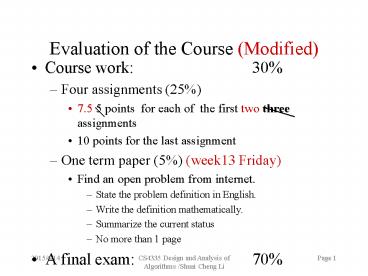Evaluation of the Course (Modified) - PowerPoint PPT Presentation
Title:
Evaluation of the Course (Modified)
Description:
Title: Single Source Shortest Path Author: xuying Last modified by: Prof. WANG Lusheng Created Date: 9/2/2003 5:10:41 AM Document presentation format – PowerPoint PPT presentation
Number of Views:80
Avg rating:3.0/5.0
Title: Evaluation of the Course (Modified)
1
Evaluation of the Course (Modified)
- Course work 30
- Four assignments (25)
- 7.5 5 points for each of the first two three
assignments - 10 points for the last assignment
- One term paper (5) (week13 Friday)
- Find an open problem from internet.
- State the problem definition in English.
- Write the definition mathematically.
- Summarize the current status
- No more than 1 page
- A final exam 70
2
Single source shortest path with negative cost
edges
3
Shortest Paths Dynamic Programming
- Def. OPT(i, v)length of shortest s-v path P
using at most i edges. - Case 1 P uses at most i-1 edges.
- OPT(i, v) OPT(i-1, v)
- Case 2 P uses exactly i edges.
- If (w, v) is the last edge, then OPT use the
best s-w path using at most i-1 edges and edge
(w, v). - Remark if no negative cycles, then OPT(n-1,
v)length of shortest s-v path.
?
Cwv
s
w
v
OPT(0, s)0.
4
Shortest Paths implementation
- Shortest-Path(G, t)
- for each node v ? V
- M0, v ?
- M0, s 0
- for i 1 to n-1
- for each node w ? V
- Mi, w Mi-1, w
- for each edge (w, v) ? E
- Mi, v min Mi, v, Mi-1, w
cwv - Analysis. O(mn) time, O(n2) space.
- m--no. of edges, nno. of nodes
- Finding the shortest paths. Maintain a
"successor" for each table entry.
5
Shortest Paths Practical implementations
- Practical improvements.
- Maintain only one array Mv shortest v-t path
that we have found so far. - No need to check edges of the form (w, v) unless
Mw changed in previous iteration. - Theorem. Throughout the algorithm, Mv is the
length of some s-v path, and after i rounds of
updates, the value Mv ? the length of shortest
s-v path using ? i edges. - Overall impact.
- Memory O(m n).
- Running time O(mn) worst case, but substantially
faster in practice.
6
Bellman-Ford Efficient Implementation
- Push-Based-Shortest-Path(G, s, t)
- for each node v ? V
- Mv ?
- successorv empty
- Ms 0
- for i 1 to n-1
- for each node w ? V
- if (Mw has been updated in
previous iteration) - for each node v such
that (w, v) ? E - if (Mv gt Mw
cwv) - Mv
Mw cwv -
successorv w - If no Mw value changed in
iteration i, stop.
Note Dijkstras Algorithm select a w with the
smallest Mw .
Time O(mn), space O(n).
7
(a)
8
5
u
v
6
8
-2
6
-3
8
0
7
s
-4
2
7
7
8
9
x
y
(b)
9
5
u
v
6
4
-2
6
-3
8
0
7
s
-4
2
7
7
2
9
x
y
(c)
10
5
u
v
2
4
-2
6
-3
8
0
7
s
-4
2
7
2
7
9
x
y
(d)
11
5
u
v
2
4
-2
6
-3
8
0
7
s
-4
2
7
7
-2
y
x
9
(e)
vertex s u v x y
d 0 2 4 7 -2 successor s v x s
u
12
Corollary If negative-weight circuit exists in
the given graph, in the n-th iteration, the cost
of a shortest path from s to some node v will be
further reduced.
- Demonstrated by the following example.
13
5
1
6
-2
8
7
7
9
2
2
5
-8
An example with negative-weight cycle
14
i1
15
i2
16
i3
17
i4
18
5
6
11
1
6
-2
0
8
12
7
7
9
2
6
15
2
5
-8
8
1
i5
19
i6
20
5
6
11
1
6
-2
0
8
12
7
7
9
2
5
15
2
5
-8
8
0
x
i7
21
5
6
11
1
6
-2
0
8
12
7
7
9
2
5
15
2
5
-8
7
0
x
i8
22
Dijkstras Algorithm (Recall)
- Dijkstras algorithm assumes that w(e)?0 for each
e in the graph. - maintain a set S of vertices such that
- Every vertex v ?S, dv?(s, v), i.e., the
shortest-path from s to v has been found. (Intial
values Sempty, ds0 and dv?) - (a) select the vertex u?V-S such that
- dumin dxx ?V-S. Set
SS?u - (b) for each node v adjacent to u do
RELAX(u, v, w). - Repeat step (a) and (b) until SV.
23
Continue
- DIJKSTRA(G,w,s)
- INITIALIZE-SINGLE-SOURCE(G,s)
- S
- Q VG
- while Q
- do u EXTRACT -MIN(Q)
- S S u
- for each vertex v ? Adju
- do RELAX(u,v,w)
24
u
v
s
y
x
(a)
25
u
v
1
10/s
8
10
9
0
s
3
4
6
2
7
5
5/s
8
2
y
x
(b)
(s,x) is the shortest path using one edge. It is
also the shortest path from s to x.
26
u
v
1
14/x
8/x
10
9
0
s
3
4
6
2
7
5
7/x
5/s
2
y
x
(c)
27
u
v
1
13/y
8/x
10
9
0
s
3
4
6
2
7
5
7/x
5/s
2
y
x
(d)
28
(e)
29
u
v
1
9/u
8/x
10
9
0
s
3
4
6
2
7
5
7/x
5/s
2
y
x
(f)
Backtracking v-u-x-s
30
The algorithm does not work if there are negative
weight edges in the graph
- .
u
-10
2
v
s
1
S-gtv is shorter than s-gtu, but it is longer than
s-gtu-gtv.































